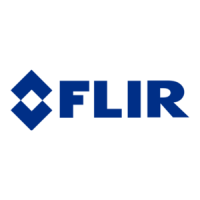16.3.2 About moisture detection
Moisture in a building structure can originate from several different sources, e.g.:
■ External leaks, such as floods, leaking fire hydrants etc.
■ Internal leaks, such as freshwater piping, waste water piping etc.
■ Condensation, which is humidity in the air falling out as liquid water due to conden-
sation on cold surfaces.
■ Building moisture, which is any moisture in the building material prior to erecting
the building structure.
■ Water remaining from firefighting.
As a non-destructive detection method, using an infrared camera has a number of
advantages over other methods, and a few disadvantages:
DisadvantageAdvantage
■
The method only detects surface temperature
differentials and can not see through walls.
■
The method can not detect subsurface damage,
i.e. mold or structural damage.
■
The method is quick.
■
The method is a non-intrusive means of investi-
gation.
■
The method does not require relocation of the
occupants.
■
The method features an illustrative visual pre-
sentation of findings.
■
The method confirms failure points and mois-
ture migration paths.
16.3.3 Moisture detection (1): Low-slope commercial roofs
16.3.3.1 General information
Low-slope commercial roofing is one of the most common roof types for industrial
building, such as warehouses, industrial plants, machinery shops etc. Its major ad-
vantages over a pitched roof is the lower cost in material and building. However, due
to its design where snow and ice will not fall off by itself—as is the case for the major-
ity of pitched roofs—it must be strongly built to support the accumulated weight of
both roof structure and any snow, ice and rain.
Although a basic understanding of the construction of low-slope commercial roofs is
desirable when carrying out a roof thermography inspection, expert knowledge is not
necessary. There is a large number of different design principles for low-slope com-
mercial roofs—both when it comes to material and design—and it would be impossible
for the infrared inspection person to know them all. If additional information about a
certain roof is needed, the architect or contractor of the building can usually supply
the relevant information.
Common causes of roof failure are outlined in the table below (from SPIE Thermosense
Proceedings Vol. 371 (1982), p. 177).
Publ. No. T559580 Rev. a486 – ENGLISH (EN) – November 17, 2010 51
16 – Introduction to building thermography

